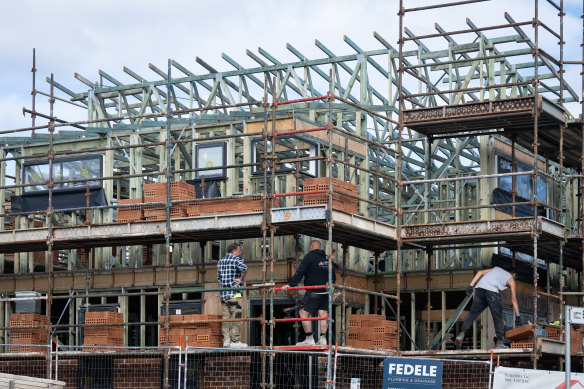Opinion
Allan’s new housing policy is good, but pausing the SRL would make it even better
In Victoria, and across the country, the social costs of Australia’s long-running failure to fix our housing system have been adding up.
Mortgage repayments and rents have risen dramatically, putting many households under significant financial stress. Low-income Australians are spending a larger share of their income on housing. So much so that younger households, who are more likely to rent or have a mortgage, have been cutting back on discretionary spending just to meet their housing costs.

Victoria will provide stamp duty concessions to encourage demand in units and townhouses.Credit: Louie Douvis
Expensive housing also means more people at risk of ending up in unstable living environments or homeless. In 2006, there were 35 homeless people for every 10,000 Victorians. By 2021, that number had risen to 47.
Against this backdrop, the Victorian government’s recently announced package of reforms is a welcome sign of serious action. Premier Jacinta Allan’s intention to change zoning laws around 50 new so-called activity centres to permit new apartment buildings, in addition to existing plans for 10 other activity centres, and a review into making subdividing suburban blocks easier, are major steps in the right direction.
The government’s proposal to fast-track development of apartment buildings and townhouses is also a good way to speed up construction of medium-density housing, but it will only be successful if these dwellings are well-designed and not overly expensive to build.
Extending existing stamp duty concessions to purchasers of any off-the-plan apartment for 12 months will also get more housing built faster. But this “saving” will probably find its way into developers’ pockets via higher prices for their apartments. And it comes at a $55 million cost to the state budget at a time of significant budget challenges for Victoria.
As we’ve increasingly seen over the past decade, expensive housing pushes people further from the CBD, which, in turn, limits access to job opportunities and reduces economic activity. It forces long commutes that lead to more congestion and lower happiness levels. Urban sprawl also makes it harder to reduce carbon emissions.
While the government also plans to release more land on the edges of Melbourne for more houses – houses that many Melburnians would want to buy – adding homes to the urban fringe only adds to sprawl and congestion, and requires governments to spend more on supporting infrastructure.
We know that high housing costs mean that fewer people own their own home and rent for longer in a system that doesn’t give renters the security that helps to make a house a home. High housing costs also damage the broader economy: curbing innovation by making it harder for people to take career or entrepreneurial risks, or access finance to start or expand a business. Expensive housing and sprawl stifle the benefits of agglomeration – the dynamism you get when people and businesses cluster, make connections and try new things.
More than 70 per cent of Australians now believe today’s children will be financially worse off than their parents, with this growing intergenerational problem at risk of becoming an intra-generational one. Young people with wealthy, home-owning parents will be more able to buy a home in the future, while those without will not – a trend that could undermine Australia’s current position as one of the most economically mobile countries in the world.
All this is why there is broad agreement among policymakers, planners and economists, and increasingly the public, that the long-term solution to Australia’s housing crisis is to build more houses in places people want to live: well-located areas with good public transport and other services, like that being proposed by the state government.
But this housing policy blitz also reinforces the need for the government to defer or dump the Suburban Rail Loop. Research shows the project is a money sink, and government spending on infrastructure is crowding out home building.
What’s more, the activity centre policy shows Melbourne doesn’t need to build an expensive new train line to justify new housing. The first stage of the Suburban Rail Loop, from Cheltenham to Box Hill, is predicted to create 70,000 new homes at cost of at least $35 billion, whereas the 50 new activity centres are expected to create 300,000 additional homes.
While the housing policy is a step in the right direction, the next move is to hit pause on the SRL and fast-forward on housing construction to build a better and fairer Victoria.
Dr Aruna Sathanapally is chief executive of the Grattan Institute. Trent Wiltshire is deputy director of the institute’s economic prosperity program.
The Opinion newsletter is a weekly wrap of views that will challenge, champion and inform your own. Sign up here.